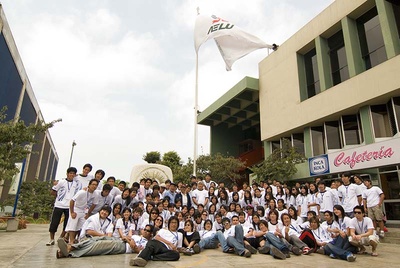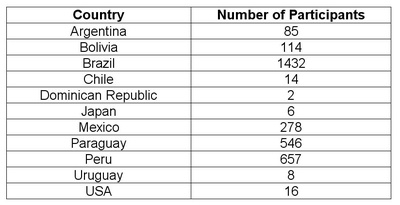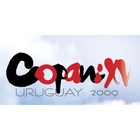At the XV COPANI, held September 17-19, 2009, young Pan-American Nikkei had a crucial role – one that will set the guidelines for future COPANI events.1
We fulfilled commitments and proposed common goals among all Pan-American Nikkei youth organizations so as to strengthen our ties and integration through international exchange programs. The common goals agreed upon are the following: the development of individuals to take up leadership roles, the promotion of cultural exchanges, and the creation of friendship and international ties.
It’s for that reason that I’d like to take this opportunity to share a little bit about our history as the Movement of Minors AELU and to explain the importance of international exchange programs for Nikkei youth. I’m also taking this opportunity to cordially invite all of you to participate in at least one of the five exchange programs currently being set up throughout the Americas, something that’ll be an unforgettable experience.
1. ABOUT THE MOVEMENT OF MINORS - AELU
The Union Stadium Association (AELU) is a sports, recreational, and cultural organization that promotes its activities in Lima, Peru. The AELU has always been dedicated to offering its associates and the Japanese-Peruvian community in particular – in addition to the general Peruvian community – services of various kinds at its sports facilities.
Through the Movement of Minors AELU, the organization has represented Peru’s Nikkei youth, along with the Japanese Peruvian Association’s Youth Department, at this year’s COPANI, which took place in Montevideo, Uruguay.
The Movement of Minors AELU – or MOVI, as many call it – is an association created on October 10, 1981, under the aegis of Felipe Agena, Marco Miyashiro, and Teruko Asato. Its goal was to educate girls, boys, teenagers, and young people so they would grow into responsible adult leaders capable of effecting changes in their society.
Under the guidance of young AELU volunteers, the MOVI carries out activities for girls, boys, teenagers, young adults, and adults. Our mottos are SERVICE, OVERCOMING, and COMMITMENT.
Among its annual activities are the Vacation Program for girls and boys between 3 and 12 years old, recreational and cultural activities every weekend of the year, and, of course, the international exchange program (which was a discussion topic at the youth panel, in addition to being addressed by every representative at the XV COPANI).
We’ve always wanted to share with other teenagers and youth in Peru and elsewhere what we’ve been doing for years at MOVI. We’ve been motivated by the idea that if in every city of our country – and after that, in every country in our part of the world – there existed an organization such as MOVI, which brings together young people who care about the welfare of minors and other youth, and who are intent on forming young leaders, that in effect we’d be creating a better world.
2. THE HISTORY OF THE EXCHANGE PROGRAMS
2.1. Antecedents
The first national exchange programs organized in Peru emerged in order to strengthen the initial contacts among Nikkei institutions in Peru. During a trip to Trujillo and Chiclayo in 1985, we carried out activities with youths in these cities. One could say that it was one of the first exchange programs held with other Nikkei youth.
Our contact with the Nikkei in Trujillo continued for a number of years, and as a result the Movement of Minors of Trujillo was created. The Trujillo youth were the participants in the first national exchange program.
As an antecedent to the first international exchanges , in 1985 our coordinator Felipe Agena traveled to Brazil to take part in the Pan-American Nikkei Convention (COPANI) to discuss the MOVI experience.
In 1987, a group of young Argentineans arrived in Peru to visit the country. The MOVI members had the opportunity to get to know them and to invite them to meetings and activities at the AELU. That same year, the COPANI took place in Buenos Aires, Argentina; we took part in it, helping to organize the youth panel. Traveling by land from Lima, we arrived in freezing Buenos Aires to have our first contact with Nikkei from a country other than Peru.
2.2. The First Exchange Program: a history of the exchange program
The various National Exchange Programs were developed with the same intent of strengthening ties with young Nikkei beyond the sphere of the capital. In fact, those ties were supposed to encompass the multifaceted realities of Peru.
On January 10, 1988, we had the opportunity to organize the Cero Exchange Program. From Trujillo, four young Nikkei arrived at the AELU for two months – an occasion that served as a learning experience, allowing us to fine tune details and to officially organize our first national exchange program.
The First Teenage Exchange Program among Nikkei Institutions in Peru was held for five days in January 1989, when for the first time 12 boys and girls, between the ages of 12 and 15, arrived from the towns of Trujillo, Pucallpa, and Barranca. The goal was to educate the participants about leadership roles, to disseminate Japanese culture, to arouse patriotism (considering that it was a difficult time in Peru because of terrorism), and imbue values such as work and personal effort.
Under the auspices of the Japanese Peruvian Association, the first national exchange program was organized by MOVI and was held at the AELU facilities.
2.3. The First International Exchange Program
In 1997, the International Association of Nikkei Clubs and Institutions (UNICIN) was created by groups in Argentina, Brazil, Paraguay, and Peru. Following the emergence of that association, we began the move toward our big dream: an International Exchange Program geared to Nikkei Youth. Thus, we took it upon ourselves to become the first youth group to organize an International Exchange Program.
In 1998, at that first youth meeting, we received 38 anxious young people who took part in one of the most fantastic adventures, something never before undertaken by any Nikkei group.
The participants came from towns located far away from Lima, such as Trujillo and Huacho, in addition to representatives from AELU’s own clubs and from different Nikkei associations such as the Nippon Country Club of São Paulo, Brazil, and the Paraguayan Nikkei Center of Asunción, Paraguay.
The first International Exchange Program lasted 15 days, and the second, held the following year, 8 days. Despite this change in regard to the duration of the activities, both were equally successful, as this second opportunity brought together 80 participants.
At that second exchange, the first Seinenbu was held, a program within the exchange that was geared to the young leaders of the teenagers taking part in the program, the majority of whom were over 18 years old.
In 2004, as a result of an alliance between the UNICIN and the Pan-American Nikkei Association (APN), for the first time Nikkei youth from Mexico took part in the event.
In 2006, we decided to change the name of that activity to “Lidercambio,” which basically refers to an exchange program geared to young Nikkei leaders of the various Pan-American Nikkei groups. This name change has been a way to use words to simplify the complexities involved in an activity of this nature.
Even so, that same year we carried out the First Internship. The Internship is a theoretical-practical training program geared to young people who wish to learn how to organize the Lidercambio, and who wish to apply that knowledge at their own institutions so as to set up events at the institutional, communitarian, national, or international level.
The Internship takes place before the Lidercambio. That allows the interns to apply what they have learned by carrying out the activities within the Lidercambio, while directly assisting the Organization Committee in their other activities.
Looking back at the history of this activity, we can see that more countries are now visiting us, among them Argentina, Bolivia, Brazil, Chile, Mexico, Paraguay, the United States, and Uruguay. Increasingly, a country’s borders are no longer barriers when it comes to the need for mutual ties and integration among us, the young Nikkei. Although we speak very different languages and dialects, we are together in the fight for our dream of a better world.
3. METHODOLOGY AND CONTENT OF THE EXCHANGE PROGRAMS
3.1. The Dreams: objectives of the exchange programs
One of the most important things we can disseminate in the exchange programs is the methodology of work. At our meetings, workshops, and recreational and cultural activities, we’ve created spaces for the participants to become more integrated and to get to know one another better, to learn what it means to be responsible, and to pledge to follow their own dreams and to help others with similar goals, while using the Nikkei culture we all share to support those ideals.
The aim of our Lidercambio is to contribute to the development of leadership abilities in young people and adolescents who belong to Nikkei institutions, recognizing their concerns while fostering their innate talents.
In order to achieve that goal, for Lidercambio 2010 we’ve come up with two Transversal Axes: Leadership and Personal Rediscovery.
We refer to them as “axes” because their function is to act as guidelines for the workshops and activities of the Lidercambio, according to a certain perspective that is supposed to become clear during the aforementioned workshops and activities.
They’re “transversal” because, by being central aspects of the proposal for the Movement of Minors, they must be present in both the content and the approach considered for each activity.
3.2. The content and activities change as well...
Since the goals are different each year, in many instances the activities – and what will be done within each one of them – change as well, for it all depends on various factors. In most instances, we realize that what we did the previous year can be improved upon. In some other instances, the experiences and assistance of former MOVI members and of our nearby friends have helped us to come up with new ideas. What we always strive to do is to ensure that our activities and meetings will offer content that will be both of interest and of use to teenagers and young people, our future leaders. The success of many of the exchange programs is owed to young people like yourselves: those who know more about teenagers and other youth, those who decide the content of the exchange programs.
4. FIGURES FOR THE INTERNATIONAL EXCHANGE PROGRAMS
From the get-go, and having as a basis our experience with MOVI, we were ready to go ahead with the exchange program. Needless to say, as we proceeded with the exchange programs we realized that we needed to improve them every year. At first, we consisted only of coordinators, but shortly afterwards we had to ask for the support of MOVI members. Then we realized that each activity needed people specialized in some aspect of the exchange program, such as logistics and finances.
We were then able to motivate Nikkei youth in Brazil, Paraguay, Mexico, Argentina, and Bolivia to organize an international exchange program in their respective cities. It’s for their sake that we find it important to make available the years in which were organized Pan-American international exchange programs:
1989 First National Exchange (Lima, Peru)
1998 First International Exchange (Lima, Peru)
1998 First International Exchange Movement (São Paulo, Brazil)
2001 First National Exchange (Asunción, Paraguay)
2003 First International Exchange (Asunción, Paraguay)
2006 First Vibra Joven International Exchange (Mexico City, Mexico)
2008 First Dale International Exchange (Buenos Aires, Argentina)
2009 First Dokkoisho National Exchange (Santa Cruz, Bolivia)
The number of people who have taken part in international exchange programs per year is the following:
To date, the number of people per country who have taken part in the international exchange programs is the following:
5. THE CHALLENGES: FUTURE EXPECTATIONS
As you can see, we’ve had nearly 22 years of exchange programs and we hope that this adventure will continue. For that reason, we must think of the future. New challenges and new goals motivate us to keep forging ahead: to ensure that more adolescents and young Nikkei experience the cultural exchange programs; to learn to improve the set-up of the exchange programs, relying on the assistance of other youth and professional associations; and to create a network for the formation of leaders in Peru and around the world. Additionally, we pledge to offer services to those whose aim is the well-being of our community and our country.
It’s also important that within this network of international exchange programs, young people be allowed to consider common short-, medium-, and long-term goals of quantifiable character. That way, we can constantly evaluate and propose new ideas that will allow us to grow as a Nikkei community, while contributing to the development of our countries.
Note:
1. I’d like to express my deep thanks for the information found in this article to the following: Felipe Agena, Mimi Miyagi, Rocío Ley, and Sebastian Kakazu, all of whom are friends, and brothers and sisters at heart.
* The above article is the result of the discussions that took place at the session “Exposure: "International Nikkei Interchanges" at the XV COPANI, held in September 19 in Montevideo, Uruguay.
© 2009 Gustavo Ytokazu Minami







